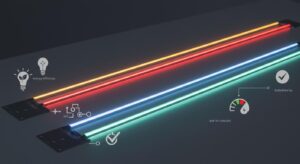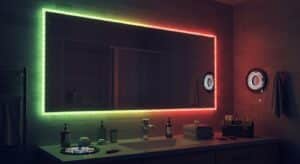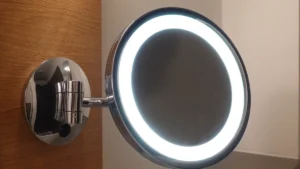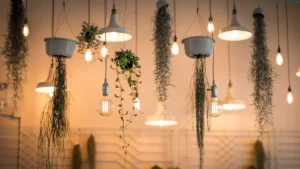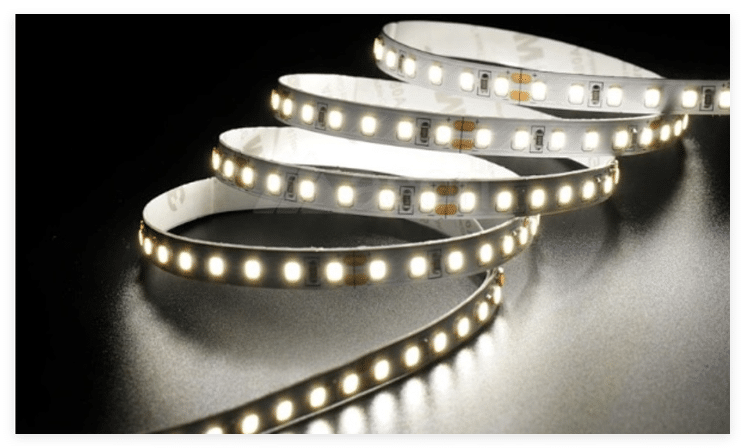
Choosing the best LED lights for homes or businesses is important. It helps save energy, money, and improves use. Home LEDs use 75% less energy than regular bulbs. They also last 25 times longer, saving on electricity bills. Businesses like LEDs because they are strong and need little upkeep. In 2023, more people chose energy-saving products. LED lights made up 27% of home and 31% of business markets. Ledsupply provides trusted options to meet these needs.
Key Takeaways
LED lights need up to 75% less power than old-style bulbs. This helps homes and businesses save a lot on electricity bills.
Picking the right LED lights means thinking about brightness, colour tone, and energy use. These help set the mood in any room.
LEDs last a long time, from 15,000 to 100,000 hours. This means fewer replacements and lower maintenance costs.
Understanding LED Lighting Technology
How LEDsupply Improves Energy Efficiency
LEDsupply helps save energy by providing advanced LED products. These lights use much less power than old-style bulbs. Using less power means lower electricity bills for homes and businesses. Their LEDs also give brighter light while using less energy.
LEDsupply’s modern lights have special heat control features. This helps them stay cool and last longer. They also offer smart lights that work with apps or voice commands. These lights are easy to use and save energy too.
Specification | Description | Impact on Performance |
|---|---|---|
Power Consumption | Uses less energy than older lighting options. | Saves money and reduces energy use. |
Luminous Efficacy | Produces more light with less energy. | Brighter light with lower energy costs. |
Thermal Management | Better heat control for the lights. | Makes lights last longer and work better. |
Benefits of LED Lighting for Today’s Needs
LED lights have many benefits for modern uses. One big advantage is how well they show colours. This makes them great for places like art studios or shops.
New LED types are also being developed. For example, some lights copy natural sunlight to improve mood and health. Micro-LEDs give clearer pictures and use even less energy. Another type, called Li-Fi, uses light to send data quickly.
Smart Lighting: Works with apps or voice for easy control.
Human-Centric Lighting: Acts like sunlight to boost well-being.
Micro-LEDs: Clearer visuals and lower energy use.
Li-Fi: Sends data fast using light.
These new ideas show how LED lights keep getting better. They save energy and offer creative, useful solutions.
LED Lighting for Homes
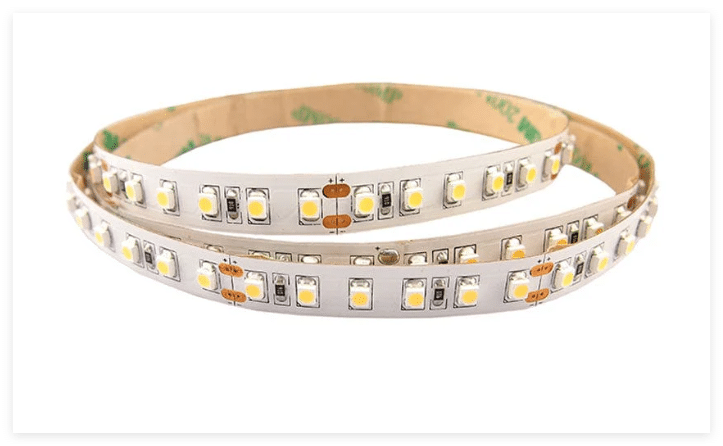
Common Types of LED Lighting for Residential Use
LED lights come in many types for home use. You can pick lamps, luminaires, or strip lights for different needs. Lamps, like A-type and T-type bulbs, are good for general lighting. Luminaires, such as decorative or directional ones, add style and function. Strip lights are flexible and make shelves or cabinets look better.
New LED technology has made these lights cheaper and more efficient. Some smart LEDs now work with apps or voice commands. These systems let you change brightness and colours to match your mood.
Factors to Consider for Home LED Lighting
Choosing the right LED lights for your home needs thought. Brightness, measured in lumens, shows how bright the light is. Colour temperature, in Kelvin, changes the feel of a room. Warm white light (2700K–3000K) feels cosy, while cool white light (3500K–4100K) is better for tasks.
Energy savings are also important. LEDs use up to 80% less power than old bulbs. This saves money on bills. They last 15,000 to 50,000 hours, so you replace them less often. Think about the purpose of the light—ambient, task, accent, or decorative—to light each room well.
Factor | Description |
|---|---|
Brightness (Lumens) | More lumens mean brighter light; great for kitchens. |
Colour Temperature (Kelvin) | Warm white for comfort; cool white for work clarity. |
Energy Efficiency | LEDs use much less energy than old bulbs, saving money. |
Lifespan | LEDs last longer than old bulbs, cutting replacement costs. |
Popular Applications: Kitchens, Living Rooms, and Outdoor Spaces
LED lights improve looks and usefulness in key home areas. In kitchens, LED corn bulbs give bright light for safe cooking. Strip lights under cabinets add style and light up worktops.
Living rooms look great with decorative luminaires or colour-changing LEDs. These let you set a calm or lively mood for events. Outside, LED corn bulbs and strip lights save energy. They make gardens and patios safer and more attractive.
💡 Tip: Pick LED lights with adjustable brightness and colour to suit activities and times of day.
LED Lighting for Businesses
Types of LED Lighting for Commercial Spaces
There are many types of LED lighting for businesses. Each type fits different needs. Linear ambient lights are great for offices. They give even light across desks. Troffers come in sizes like 1 ft. x 4 ft. or 2 ft. x 4 ft. These are perfect for ceilings in shops. For factories, low bay and high bay lights are ideal. They light up big spaces well.
LED strips are another useful choice. They can highlight products in stores. In warehouses, they work as task lights. These strips let you adjust brightness for various uses. They last long and save energy. This lowers upkeep costs, making them a smart pick for businesses.
Luminaire Type | Minimum Light Output | LE |
|---|---|---|
Linear ambient | ≥ 375 lm/ft. | ≥ 131 lm/W |
1 ft. x 4 ft. troffers | ≥ 1,500 lm | ≥ 120 lm/W |
2 ft. x 2 ft. troffers | ≥ 2,000 lm | ≥ 123 lm/W |
2 ft. x 4 ft. troffers | ≥ 3,000 lm | ≥ 140 lm/W |
Low bay | ≥ 5,000 to < 10,000 lm | ≥ 143 lm/W |
High bay | ≥ 10,000 lm | ≥ 175 lm/W |
Key Considerations for Business Lighting Needs
When picking LED lights for your business, think about energy use, lifespan, and costs. LEDs use up to 90% less energy than old bulbs. This cuts down on electricity bills. They last much longer, up to 25 times more. This means fewer replacements and lower maintenance costs.
Good lighting helps workers feel better and work harder. Studies show 68% of workers dislike their office lighting. Proper LED lighting helps people focus, feel less tired, and sleep better. Cool white light, like 6,500K, is best for staying alert at work.
💡 Tip: Choose LED lights that work with motion sensors and dimmers to save more energy.
Examples of Applications: Offices, Retail, and Warehouses
LED lights improve offices, shops, and warehouses. In offices, linear ambient lights give steady light. This reduces eye strain and helps people work better. Shops use LED strips to make products look great with clear colours.
Warehouses need strong and tough lights. High bay lights brighten large areas, keeping them safe and efficient. LED strips can also be used for tasks in storage areas. You can adjust their brightness for different jobs.
Using LEDs saves energy and makes spaces work better. For example, a transit company in Pennsylvania cut lighting energy by 64%. This saved them over $617,000 each year. A bank also saved 61% on energy, earning back their costs in just 10 months.
🚀 Note: LEDs last 35,000 to 50,000 hours. Old bulbs only last 1,000 to 2,000 hours.
Comparing Key Factors: Homes vs Businesses
Energy Efficiency and Cost Savings
LED lights save a lot of energy for homes and businesses. At home, LEDs use 75% less energy than old bulbs. This lowers electricity bills. For businesses, the savings are even bigger. LEDs can cut energy use by 90%. This makes them great for places needing lots of light. Changing to LEDs also improves lighting quality.
Businesses can use sensors with LEDs to save more energy. These sensors adjust light levels based on natural light. This keeps spaces bright while cutting costs. Switching to LEDs also reduces carbon emissions. Both homes and businesses benefit from these savings.
💡 Tip: Use motion sensors and dimmers to save more energy.
Brightness and Light Output Requirements
LED brightness is measured in lumens, not watts. Lumens show how much light is given off. Warm white LEDs (2700K–3000K) make homes feel cosy. Cool white LEDs (3500K–4100K) are better for tasks. Offices need even lighting to avoid eye strain. Warehouses need strong lights like high bay LEDs for big spaces.
The amount of light reaching surfaces is called illuminance. Poorly aimed lights waste energy and reduce brightness. LEDs keep 70% of their original brightness for up to 100,000 hours. This means fewer replacements and lower costs over time.
🚀 Note: Pick LEDs with high Colour Rendering Index (CRI) for better colour and atmosphere.
Durability and Lifespan of LED Products
LEDs last a long time and are very durable. Home LEDs work for 25,000 to 50,000 hours. Business LEDs last longer, up to 100,000 hours. This reduces maintenance and avoids interruptions.
LEDs rarely fail completely but may lose brightness over time. When brightness drops to 70% of the original level, the LED’s useful life ends. This durability makes LEDs a smart choice for homes and businesses.
Installation and Maintenance Considerations
Installing LEDs is simple but differs for homes and businesses. At home, you just replace old fixtures with LED ones. Maintenance is easy, like cleaning lights now and then.
For businesses, installation can be more detailed. Group relamping saves time and money. Preventive maintenance stops problems before they happen. Some companies offer Lighting as a Service. They handle costs and setup, so businesses can focus on work.
💡 Tip: Clean and check LED lights regularly to keep them working well.
Common Misconceptions About LED Lighting
Are LED Lights Too Expensive Upfront?
Some people think LEDs cost too much at first. But, they save money over time, making them worth it. For example, Bright Manufacturing Plant added LEDs to a 50,000-square-foot space. They spent £50,000 but saved £35,000 yearly on lighting. This means they got their money back in just 1.4 years. Similarly, the City of Springfield switched 10,000 streetlights to LEDs. The project cost £2.5 million but saved £550,000 yearly. They recovered the cost in 4.55 years.
LEDs also give great returns on investment (ROI). A £400 LED setup saves £219 yearly. Over five years, this gives a 396.25% ROI. The payback time is only 1.83 years. These examples show how LEDs cut costs over time. They are a smart choice for homes and businesses.
💡 Tip: Think about long-term savings when looking at LED costs.
Do LED Lights Work Well in All Environments?
LEDs work well in many places, but conditions matter. Blue LEDs are 93% efficient, while white ones reach 76%. Red LEDs work at 81% efficiency in good conditions. Things like heat, humidity, and brightness can affect how they perform.
New LED designs are better than older ones. For example, white and red LEDs reach 3.4 µmol J−1. Blue and red LEDs go up to 4.1 µmol J−1. Older systems only reach 2–3 µmol J−1. This makes LEDs useful in homes, offices, and factories.
Is LED Lighting Always the Most Energy-Efficient Option?
LEDs are one of the best energy-saving lights today. The IEA 4E SSL Annex says LED retrofits cut environmental harm by 44% for T5 lamps. For T8 lamps, the reduction is 61%. LEDs also have no mercury, making them safer for nature. Over 85% of old lamp pollution comes from greenhouse gases. LEDs lower this, making them eco-friendly.
Using LEDs wisely saves even more energy. Adding motion sensors and dimmers helps reduce power use. This ensures you get the best from your LED system.
🚀 Note: LEDs save energy and help protect the environment.
Tips for Choosing the Right LED Lighting
Checking Needs and Space
Start by thinking about what you need from your LED lighting. Each area in your home or business needs different lighting. Kitchens need bright lights for cooking. Living rooms look better with soft, relaxing lights. Outdoor areas need strong, weatherproof LEDs for safety and style.
Think about the size and shape of the space. Bigger rooms need brighter lights to stay well-lit. Smaller spaces might need adjustable LEDs to avoid being too bright. Decide if the lighting is for work, relaxing, or decoration. Pick the right type of LED lighting for each purpose.
💡 Tip: Dimmable LEDs let you change brightness for different times and tasks.
Learning About Lumens, Colour, and Energy Use
Knowing how LED lighting works helps you choose wisely. Lumens show how bright the light is. Colour temperature changes the mood of a room. Wattage tells you how much energy the light uses.
Here’s a simple guide to key terms:
Metric | What It Means |
|---|---|
Efficacy | Shows how well the light turns energy into brightness. |
Luminous Flux (Lumens) | Measures brightness; tested under specific conditions. |
Wattage | Shows energy use; should stay within 10% of the stated value. |
Colour Rendering Index (CRI) | Rates how true colours look under the light (100 is best). |
Correlated Colour Temperature | Warm lights have low Kelvin numbers; cool lights have high ones. |
R9 | Rates red colour quality; higher numbers mean better colour. |
Warm white LEDs (2700K–3000K) make homes feel cosy. Cool white LEDs (3500K–4100K) are good for tasks like reading. For offices, higher Kelvin lights (5000K–6500K) help people focus better.
🚀 Note: High luminous efficacy LEDs save energy and give great brightness.
Choosing Quality and Value
Good LED lighting costs more at first but saves money later. High-quality LEDs last longer and need fewer replacements. This lowers maintenance costs over time.
Look for LEDs with trusted certifications like LM-79 and LM-80. These prove the lights work well and last long. Features like heat control stop overheating and make LEDs last longer.
Quality LEDs give steady light and true colours. Cheap LEDs may flicker or wear out fast, costing more in the end. Spending more on good LEDs saves energy and gives better lighting for years.
💡 Tip: Pick LEDs with warranties to protect your money and ensure reliability.
LED Grow Lights for Homes and Businesses
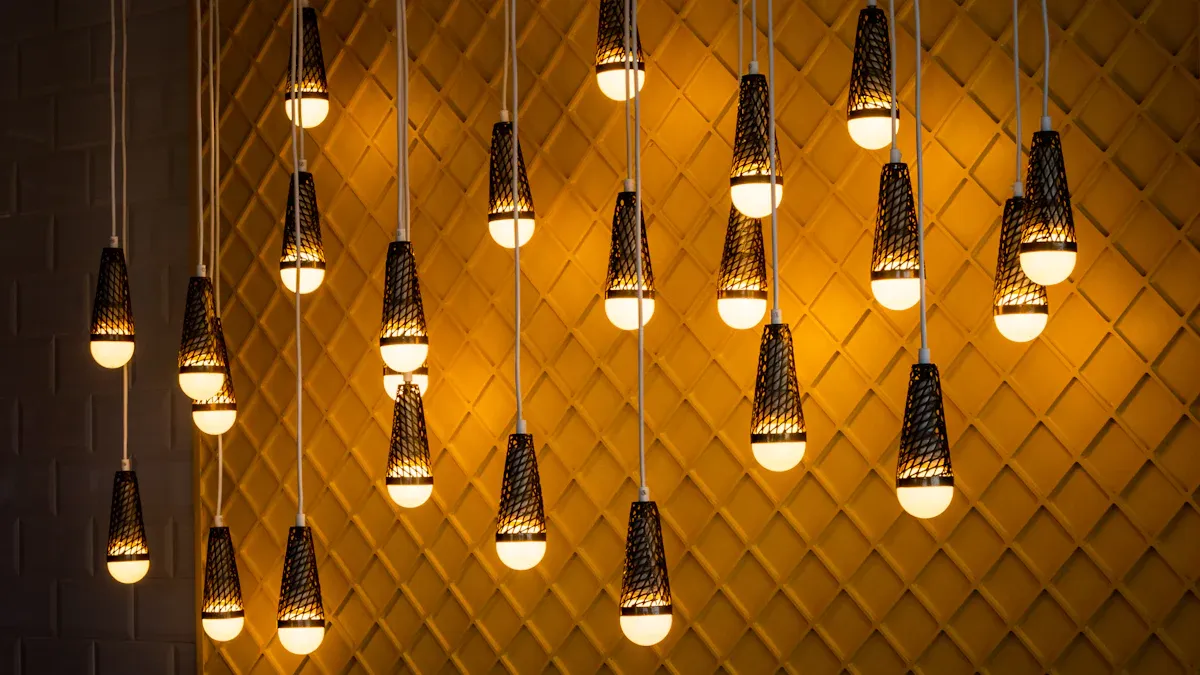
Best LED Grow Lights for Indoor Gardening
LED grow lights can change how you do indoor gardening. These lights copy natural sunlight, helping plants grow well. They are perfect for growing herbs, vegetables, and flowers indoors where sunlight is limited.
Newer LED grow lights, like full-spectrum ones, let you adjust light settings. This means you can match the light to each plant stage, like sprouting or flowering. For example, red and blue lights help plants make food, while white light keeps plants healthy overall.
LED grow lights are energy-saving and don’t get too hot. This means your plants stay safe, and your electricity bills stay low. Popular choices like the Mars Hydro TS 1000 work well and last long, making them great for home gardeners.
🌱 Tip: Keep LED grow lights at the right distance from plants for the best results.
Efficiency and Lifespan of LED Grow Lights
LED grow lights are better than older lights in many ways. They use less energy but give high-quality light, saving money and helping the environment. These lights last between 50,000 and 100,000 hours, so you won’t need to replace them often.
Here’s how LED grow lights compare to traditional ones:
Feature | LED Grow Lights | Traditional Grow Lights |
|---|---|---|
Lifespan | 50,000 – 100,000 hours | 10,000 – 30,000 hours |
Energy Efficiency | High | Moderate |
Heat Output | Low | High |
You can also change the light spectrum to fit your plants’ needs. This helps plants grow better and produce more. Because of this, LED grow lights are a top pick for both hobby gardeners and professionals.
💡 Note: Clean your LED grow lights often to keep them working well and lasting longer.
Applications of LED Grow Lights in Commercial Settings
Businesses gain a lot from using LED grow lights. These lights give steady, good-quality light, which improves crop growth and quality. They are used in vertical farms, greenhouses, and indoor farming.
Urban farms depend on LED grow lights to grow crops all year. For example, a vertical farm in Singapore uses full-spectrum LED lights to grow more food in small spaces. Big lettuce farms also report higher crop amounts because of the precise light from LED grow lights.
The market for commercial LED grow lights is growing fast. This is due to more people living in cities and the need for energy-saving solutions. By 2032, this market could reach $14.57 billion, growing by 20.08% each year.
Market Segment | 2024 Value (USD Billion) | 2032 Value (USD Billion) | CAGR (%) |
|---|---|---|---|
Commercial LED Grow Light Market | 3.37 | 14.57 | 20.08 |
🚀 Tip: Choose LED grow lights with adjustable settings to help plants grow better and save energy in business setups.
LED lights are great for homes and businesses. At home, they give a warm, cosy feel. In businesses, they are bright and save energy. LEDs can last up to 50,000 hours. This means you spend less on replacing them. Unlike fluorescent lights, LEDs have no mercury. This makes them safer for the planet.
Research shows tunable LEDs help people focus better at work. They don’t flicker, so they are easy on the eyes. This is perfect for long hours of work. To get these benefits, check your space and learn about LED options. Buy good-quality LEDs for better lighting and lower costs. This also helps the environment.
🌟 Tip: Pick LEDs with adjustable brightness for different tasks and times.
FAQ
Why are LED lights better than old-style bulbs?
LEDs use less power and last much longer. They shine brighter and stay cooler, making them safer and better for homes and businesses.
Do LED lights work well in cold places?
Yes, LEDs work great in cold weather. They are perfect for outdoor areas, freezers, and cold spaces where old bulbs might stop working.
How can you pick the best LED light for your room?
Think about brightness, colour, and energy savings. Choose lights that fit the room’s use, like relaxing, working, or showing off certain spots.
See Also
Comparative Analysis of Bright LED Strips for All Uses
Selecting the Perfect LED Strip Lights for Linear Illumination
The Benefits of Backlit LEDs for Commercial Spaces
